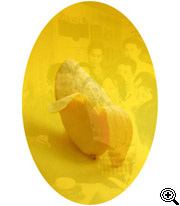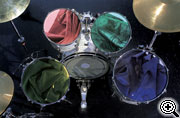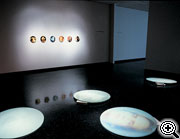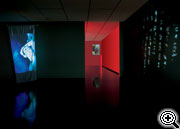Disappearing Acts
Hiram To´s installation, I Love You More Than My Own Death, explores our fascination with spectacles of power, greed and self-interest, qualities that are often associated with deceit. Indeed, duplicity - the ambiguous territory that preys upon emotions of hope and despair as it jumbles lies and truth - is the artist´s central interest, especially as it performs in identity formation and self-representation.
It is worth considering the artist´s preoccupation with the dynamics of identity construction to provide insights into his motivation. The force of Hiram To´s vision lies in how seamlessly he coalesces high and low cultural symbols and levels international artworld trends and entertainment models. Since the early 1990s, he has used these constructs to examine the complex ethics of an individual´s social politics in a capitalist, celebrity-obsessed world. His art ties materialistic impulses and cravings for fame to self-image. If we shape identity using media culture as a foremost model and venerate celebrities whom everyone recognizes but no one really knows, what is the consequence? What holes are we trying to hide? What wounds are we trying to heal?
Hiram To frequently refers to issues of representation and ethnic marginalization, thereby evincing the individual as a victim of global consumerism, or racial and colonial hegemony within an East-West antithesis. The devices he quotes channel particular beliefs that mirror historical periods of cultural production and reception. Ambiguity and illusion are qualities well utilized by To, and they are heightened by installations whose many components resonate with richly layered and romantic metaphors culled from historical archives and the fantasy worlds of consumer spectacle, as played out in cinema, television game shows, music, advertising and fashion.
To´s earlier works lay bare the seduction of fashion and branding with alaconic wit as they look deep into the pool of Narcissus to ask: If we don´t attain the glamour we crave, are we nothing? In this respect, he uses high and low visual cultural references solely as ideological templates to position himself and his audience inside the mechanisms of identity production and to force the questions: Who are we, really? Who do we want to be?
This takes us to the artist´s main viewpoint: identity is an unreliable concept; self-image is fashioned and reformed over time in continual transactions, influenced by changing, external circumstances. As the twenty-first century progresses, this may prove to escalate given technological and scientific advances; however, perhaps individual transformation has always been an adaptive aspect of the human psyche, a hard-wired response. As such, one constant in Hiram To´s installations, revisited in I Love You More Than My Own Death, is a scenario in which the self appears to have exited the stage, leaving behind extravagant traces of an "identity" that never really was.
The title of Hiram To´s Venice installation - I Love You More Than My Own Death - is the first clue to the artist´s fixation on duplicity. It is a direct reference to a scandalous moment in the history of the Venice Biennale when, in 1993, a then New York-based, independent curator, Christian Leigh, produced "I Love You More Than My Own Death" (also titled "Transactions"), a "giant cross-generational art-world ball"1 that showcased works by lesser known and renowned artists, designers and architects. Intriguingly, the project turned out to be produced solely through the power of Christian Leigh´s heightened celebrity and, as later reported, his longstanding deceit. He had failed to raise funds for the project, a fact discovered only after the exhibition closed, when no one involved in the project´s production was paid and the Italian authorities impounded the art for five years.2 Indeed, Leigh proved to be viewed by many as imposter, someone who had briefly and mysteriously infiltrated the artworld, leaving betrayal and confusion in his wake. Gallerist Thaddaeus Ropac reminisces:
I think at Venice [Leigh] got too greedy: his expenses, his ambitions were out of control and he just dreamt someone would pick up the bill. He gave me a wonderful tour of the show before it opened, with two collectors who were also impressed. There was a big party, and he vanished the next day. He was never seen again.3
Hiram To´s citation of Christian Leigh´s exhibition title is partially due to the project´s unexpected public failure on the most venerated of international art playgrounds. However, he is especially intrigued by the notoriety of a star curator´s fall from grace (in artworld circles, at least) and Leigh´s disappearing act. It is these deeper levels of inquiry about identity that Christian Leigh personifies. As the artworld learned soon after Leigh´s disappearance, he was not who he claimed. Instead, he was and remains an enigma (probably Ezra Saftia, born in Brooklyn) who cultivated successive identities in various creative industries: Kristian Leigh (an 18-year-old haute-couture designer), Christian Leigh (an influential contemporary art curator and critic) and C.S. Leigh (a screen writer and film director). Writer Adrian Dannatt describes Leigh as "a master of the vanishing act and reinvention" noting that "every time he disappeared and changed his name," he left "a trail of suspicion."4
But, can one fault Leigh for playing the game and giving the artworld´s actors what they wanted, even for a brief time: exposure, celebrity, glamour and parties? C. S. Leigh could be viewed as the 1980s precursor to the twenty-first century´s enduring fascination with celebrity lifestyles and the unwavering media focus on the cult of personality, one that now extends to everyone the possibility of achieving stardom and status through the public competitions of television shows like American Idol and Project Runway (and their many variations around the world). In this broader social context, are we succumbing to an accelerated need for new experiences, as these shows suggest? Does C. S. Leigh´s continual transformation constitute a sickness or a healthy desire for new adventures? Are we all on such a path?
American psychologist Mark Stone, in Life-Lies and Self Deceptions, uses the analogy of the magician´s sleight-of-hand to explain how self-deception can become a normal, albeit unrecognized and unconscious, act that he calls life-lies. Life-lies are "a ploy to rescue oneself from a state of uncertainty and inferiority" and "a shield from the harshness of reality"5as Stone puts it:
We see only what a magician wants us to see. A magician leads us to deception by directing our attention to what and where he/she wants us to focus our attention, and not upon what may actually be happening. . . While we may not see ourselves as magicians, we actually practice magic and perform countless mental illusions. They take the form of life-lies.6
Hiram To´s I Love You More Than My Own Death is steeped in life-lies and the intrigues and deceptions they engender through cultural production in mass culture. Indeed, his initial reference to C. S. Leigh´s present-day transgressions within the artworld only brushes the surface to hint at more revelations for the audience to uncover.
Overall, the installation charts historical moments of fraud and trickery in the realms of past entertainments (magic acts) and socio-cultural politics (China´s Cultural Revolution and its actors). The tragedy of Mao Zedong´s Cultural Revolution of the mid-twentieth century is introduced through brightly coloured lenticular photographs of ripened mangoes, peaches and pomegranates that dominate the installation. Like the glowing fruit rows on flickering slot machines, these intensely erotic images promise riches and luxury for all who play the game. Instead, the three-dimensional images shift when the viewer´s position changes, revealing a more sinister theatre of shadow images that are initially masked by the tempting fruit. These ghostly traces recall events in the progress of the Cultural Revolution, when Marxist socio-political programmes that promised to fulfill the ideal of a strong, prosperous and socially egalitarian China, instead turned into widespread cultural suppression resulting in incarceration and death for many Chinese citizens.
In another densely layered sub-theme, Hiram To calls forth the ghosts of two of the late-nineteenth century´s most celebrated magicians, Ching Ling Foo, a Beijing-born conjurer who performed in America in 1898 to great acclaim, and Chung Ling Soo, his contemporary, who was actually an American named William Ellsworth Robinson. Robinson masqueraded as a "Marvelous Chinese Conjurer" both on and off the stage. His racial deception greatly advanced his career until his death in 1918, when he was fatally shot while performing his renowned bullet catching act, at which point his identity charade was unmasked.
I Love You More Than My Own Death provokes questions about our personal and social relationships to authenticity and how we understand our own actions within the world. What do we believe? Do we have difficulty reconciling moral positions when dwelling in a culture of excess that increasingly values the surfaces of things as a way to block out deeper social ills and psychoses? Surely, we can thoroughly appreciate the luscious depictions of the mango, the peach and the pomegranate without knowing their darker symbolic import - whether that symbolism lies in the drama of a distant Cultural Revolution or in the other densely layered historic and cultural references. Is there a risk to individual morality and purpose in turning an apparently blind eye to the masquerade of a Chung Ling Soo and embracing the entertainment value of duplicity?
Perhaps, C. S. Leigh, the chameleon, is not so different from us. He is a shape-shifter, his ongoing transformation motivated by another appearance on the stage. After all, when the performance runs its course and the audience´s enthusiasm wanes, isn´t a sleight-of-hand imperative to continually surprise and tease, keeping the game in play, an intriguing puzzle for the audience and the entertainer alike?
Donna McAlear
-----------------------------------------------------------------------
Notes:
1. Alexi Worth, "The trouble with Christian - Whatever Happened to Christian Leigh - Biography," Artforum, March (2003) (January 25, 2007).
2. See Carol Vogel, "'Captive' Works are Being Freed," New York Times, March 20, 1998 (January 25, 2007).
3. Thaddaeus Ropac, cited in Adrian Dannatt, "The Talented Mr. Leigh," The Sunday Times Magazine, August 7, 2005 (January 25, 2007).
4. Dannatt, Ibid.
5. Mark H. Stone, Life-Lies and Self-Deceptions (Chicago: The Phaneron Press, 2002) (February 10, 2007).
6. Stone, Ibid.
HIRAM TO
Born in Hong Kong, Hiram To has exhibited and curated internationally, with his works acquired for the collections of the National Gallery of Australia, Sydney's Powerhouse Museum and the Queensland Art Gallery. To was invited by London's Camden Arts Centre and Institute for International Visual Arts to mount a one-person exhibition in 1994, while in 2002, The Winnipeg Art Gallery held a survey of his installations. He has worked as an arts and features writer for Hong Kong's South China Morning Post and The Standard, and for the past decade, he also developed a career in media communications.






